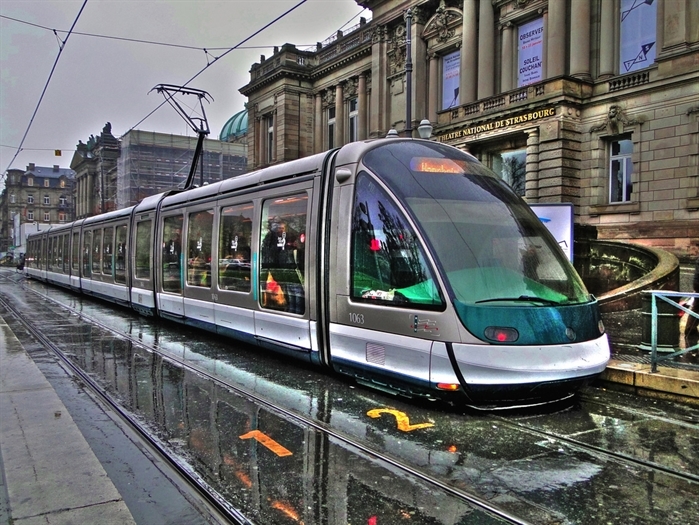
Flickr user Ingolf (cc).
Tramway in the city center of Angers, France.
Published monthly, MPC’s Talking Transit provides updates about transit-related activities around the world.
Get In the Loop on all the latest local, national and international transit headlines.
Did You Know?
Walking is a major mode of access to transit stations. At urban stations on rail networks like the Chicago Transit Authority's El lines or the Washington Metro, the largest share of riders get to the station by foot. That’s also true for commuter rail networks like Metra, where most riders at downtown stations and at major urban and inner-suburban stations arrive to the station by foot; for example, 47 percent of people who arrive at the LaSalle Street Metra Station get there by walking, compared to just 15 percent by car, 7 percent by taxi and 29 percent by transit. For those riders, the surrounding landscape matters—a lot. An unappealing pedestrian landscape near a transit system may reduce ridership, while a convenient, attractive environment can build a sense of comfort and interest in using the system.
Transportation as the foundation of better public space
Transportation capital projects often provide significant improvements in the ability of individuals and freight to move around, resulting in faster connections and reduced congestion. The Ashland Avenue bus rapid transit project, for instance, will make it possible for buses to shoot down the street almost twice as quickly as today, allowing people to reach more jobs in less time.
When building new transportation improvements, however, it’s important to consider community impacts. For example, the Metropolitan Planning Council (MPC) created an Ashland Avenue mapping tool to ensure that the Ashland bus rapid transit line generates economic and community development that improves access to jobs and quality of life for the city's residents. Permanent, iconic transit stations planned for the route can and should serve as community hubs and attract both residential and retail development.
However, clearing the way for a new highway, for example, requires the acquisition of a broad and long right of way, cutting through existing natural and built environments, which can be detrimental to neighborhood life or pedestrian connections. When completed in 1961, the Dan Ryan Expressway allowed people to drive far more quickly from the Chicago Loop to the city’s South Side; it also produced an almost insurmountable—and certainly unaesthetic—barrier for people trying to make trips by foot between surrounding neighborhoods, thanks to the demolition of hundreds of homes and the proliferation of vast swathes of concrete in the middle of the community. Too often mobility comes at the detriment of enjoying the urban landscape.
When thought through appropriately, though, transportation investments can be implemented not only to provide the kinds of speed and congestion-relieving benefits traditionally desired from such projects, but also to offer a more appealing public environment. MPC’s work on transportation policy advocates for the integration of placemaking into infrastructure investments, emphasizing the importance of not only improving public mobility, but also improving the livability of the areas affected by those improvements.
This was the theme of an exhibit I recently attended in Paris, France, called “Tramway: A French School.” The exhibit emphasized that, more than just providing mobility benefits, transportation projects like tramways (referred to in the U.S. as streetcars or light rail, depending on the context) offer the opportunity to rethink surrounding streets and the urban landscape itself.
French cities have invested steadily in new tram lines, extending these train systems into 26 cities today, up from just three in the early 1980s. Four more cities have new tram systems currently under construction. These systems have done more than just provide new and improved public transportation links through their cities. Rather, the networks have become useful complements to the urban life of the surrounding areas.
As the guide to the exhibition notes, the French tramway “school” provides:
a transportation project [that is] enriched by the following components: an innovative and personalized design for the trains; an improvement of the public space around the lines, with urban landscapes sometimes transfigured; the creation of emblematic stations; the creation of a unique collection of urban “furniture” [such as benches and platform canopies]; an artistic and cultural programmatic accompaniment; and new systems for traveler information and visual information.
A trip on a French tramway line, or a walk in the neighborhoods surrounding such a rail line, quickly demonstrates why focusing on the aesthetics of such a project plays such an important role in complementing the mobility benefits inherent in transportation. Tramway tracks are often sunk into beds of grass, enlivening the landscape and adding color. Tramway vehicles are designed to look modern and welcoming. Tramway streets are outfitted with handsome pavement treatments and unique lighting. And major tramway stations are impressive gathering spaces that open up to the surrounding city.

Tramways have different feels depending on the city. This tram is in Strasbourg, France. The following three are in Montpellier, Nice and Paris, respectively.
Flickr user Alexandre Prevot (CC)
These improvements augment the surrounding neighborhoods, making them better places to live, work or play, and they guarantee that the transportation investments benefit both the people who ride the trains and the people who happen to be passing through the surrounding area.
In the Chicago region, new transportation investments, such as bus rapid transit lines or upgrades of existing rail lines, offer the opportunity to integrate improvements that lead to physically beautifying surroundings. With smart thinking about improved landscaping, artful stations and a high-quality pedestrian realm, faster transportation can also mean a more enjoyable community for everyone.